Business owners often wonder whether or not shoppers read product descriptions or if it’s so indispensable to write them.
This mindset results in a bland product description that only shows features—and that’s a flawed approach.
Truth is, 82% of shoppers do read product descriptions, and it influences their purchase decision.

But knowing this won’t make it easier for you to write a product description, as it can be tough to write copy that resonates and makes sales if you’re not a copywriter by trade.
Fortunately, if you want to avoid writing a plain description that most visitors ignore, this guide will help you find the purpose and process behind a compelling product copy.
This post will cover:
- The purpose of your product description and why it’s important
- The six essential elements of an impactful product description
- A procedure to write great product descriptions all the time
- Five product description examples you should learn from
So keep scrolling if you want to learn how to write a product description that sells.
The Purpose of Your Product Description and Why It’s Important
The goal of your product page is to convert interested prospects into paying customers.
Different from what most people think, the role your product description has on the product page is not to just show features. It’s to address your customer’s objections until they have no reason not to buy.
You see, what’s stopping interested shoppers from purchasing your product are their objections.
They’re constantly wondering if your product is legit, 100% secure, a real solution to their problem, do what they intend to do, or if there’s a better deal in another store.
Your description is meant to address all those mental barriers with copy that demonstrates why your product is the right fit.
The hard part, however, is to know exactly what those objections are.
6 Essential Elements of a Powerful Product Description
There are many ingredients in the making of an effective product description.
Here, we’ll go through six of them and explain how to use them in your copy.
1. A Pain Point to Address
A pain point is a specific problem, desire, or goal that your customers have. Great copy uses it when trying to provoke a powerful feeling in the reader.
Addressing pain points is how you anchor your prospect’s interest toward your copy and motivate them to read.
To know your customer’s pain points, you must do detailed customer research to discover the real problems, hustles, and desires that your audience is living with right now.
Doing so will allow you to write a product description that resonates with shoppers and incentivizes them to buy.
For example, you can include pain points in places your potential customer is more likely to read first, such as:
- Bullet points
- Headers
- The first sentence
- Before a call-to-action
The reason behind this is to generate an emotional reaction and make prospects more likely to consider your product. So make your research worth it by including pain points where any skimmer will read it.
2. Anti-Objections
As said earlier, the difference between an interested shopper and a paying customer is that the former is full of objections.
Your product page’s job is to address as many of their objections as possible to make it easier to buy. And your product description must be made just for that.
When doing customer research, figure out what are the most present objections they face when they’re shopping for specific products:
- Is there free shipping?
- Is it under my budget?
- Will it solve my particular problem?
- Is it worth the money?
Buyers only care about what your product can do for them, so don’t be general. You can address objections in your product description with specific use cases, benefits, and features that fit with your customer’s problems.
FAQs also deliver a lot of value to your prospects, as they can directly answer common objections and help your customers make a better buying decision.
3. Storytelling
The best proven way to connect with your customer’s emotions (and sell) is with storytelling.
You see, an engaging story will make your prospects forget that you’re selling them a product—giving you more chances to make the sale.
It isn’t common to find product descriptions with stories. So for interested shoppers navigating your product page, it’d be a pretty unique experience for them to read an exciting story that somehow makes them desire the product even more.
There are plenty of ways to do this. Including:
- An engaging story about how your team invented your product.
- If your product represents a narrative, such as a fight against AIDS or cancer, climate change, or animal testing (or something as simple as changing your pet’s diet). You can tell an adjacent story that’s related to it.
- The real story of an ideal customer that succeeded with your product.
- How your product is made in a unique way that sets you apart.
If you think you don’t have a story to tell, then think again. Everyone has a story.
4. A Skimmable Format
Many shoppers skip reading the product description assuming it will be filled with fluff—all because it is formatted in a massive block of text.
You see, you do nothing if people don’t read your copy. Formatting your product page in a way that’s easy to skim will make these shoppers more likely to read the entire description. That’s why you must do it if you want it to make more sales.
For this, you can start by following the best practices:
- Adding bullet points
- Make the font bigger
- Write shorter paragraphs and sentences
- Simplify the language so anyone can understand what you’re saying
- Use active voice in your copy instead of passive
- Add icons that represent your product’s features.
If you’re skeptical, you can do a heatmap test to see if visitors are reading your product copy. Or even something as simple as asking a few customers directly if they actually read it.
In the end, the best conversion rate is the one that keeps improving.
No matter your niche. Every shopper on the internet has the same objection when it comes to social proof.
What happens is that we can’t simply trust our money to anyone on the internet making big claims about themselves.
And with social proof, you’re telling your shoppers that buying from you is 100% secure and that the product will fit their needs—bypassing such primitive objection.
You can include proof in your product description by:
- Quoting customer reviews and testimonials.
- Mentioning what it has achieved to other customers.
- The rewards your brand got from your product.
- Statistics that prove that what your product truly works.
If you’re running short of social proof. You can always reach out to your current customers and ask them to write a testimonial or a story for you. You can even try to reward them for doing so.
Even when it comes to statistics, you can conduct your own research and pay your customers to participate in your study.
Social proof is something you must start gathering proactively, so don’t wait for it to come to you.
6. Action-oriented
In the exact moment when your prospect has no logical objections, is emotionally attracted to your product, and is already planning how to use it. That’s when you need to cast a powerful call-to-action that will make them commit to the purchase.
You see, if people don’t know what to do after reading your product page, then it serves no use. The purpose of writing copy is to drive action, and your product description isn’t an exception.
To be actionable, you need to determine what the following action is. Is it to add the product to the shopping bag? To subscribe to your plan? To schedule a call? Believe it or not, adding a product to the cart isn’t the only option.
When writing a description, you must frame the next action right from the start and position it as a riskless step—concluding with a call-to-action (CTA).
You can write a CTA in multiple ways. Some best practices include:
- Reducing to only one CTA. Overwhelming the visitor with too many options will reduce their chances to buy.
- Positioning your CTA as a positive opportunity for them and not as a favor for you.
- Making it easy to understand. Briefly explain how to buy your product.
- Adding some urgency and a reason to act now. When your product has limited supply, make your customers know it so they don’t miss the opportunity.
You can always improve your CTAs (as well as product descriptions and product pages). So don’t forget to experiment with your CTAs constantly to keep optimizing your conversion rates.
How to Write a Great Product Descriptions All the Time (A 9 Steps Checklist)
Now that you know the ingredients of a product description that makes an impact, you need to follow a recipe.
This recipe follows a simple procedure to write copy. So feel free to copy and paste this whenever you need to write a decent product description for your store.
Taking what was covered before, here’s how your writing process should look like:
- Do customer research. Gather pain points, common objections, and the general profile of your audience.
- Define your brand voice, such as preferred words, tone, and the values you want to represent.
- Make a list of objections that your customers have when shopping for a product like yours. Write an answer for each of them, explaining how your product solves those doubts.
- Write a headline that targets a strong pain point.
- Write a description that follows and answers the objections in order of occurrence. Starting with the first objection that comes to mind, followed by the second, and so on.
- Add social proof to the copy naturally and when relevant.
- Frame the next action and include a clear call-to-action.
- Make it easy to skim.
- Edit with your customer’s eyes and ask yourself: Do you sound honest and trustworthy? Is your copy so detailed that you can imagine yourself using your product? Would you buy this over a cheaper option?
Note that this process isn’t set in stone. Feel free to tweak and improve it until you come up with a procedure that works for you.
The purpose of this checklist is to give you a minimum-viable workflow that you can execute every time and write a product description that works.
5 Product Description Examples You Should Learn From
Example #1. JOI’s Almond Base
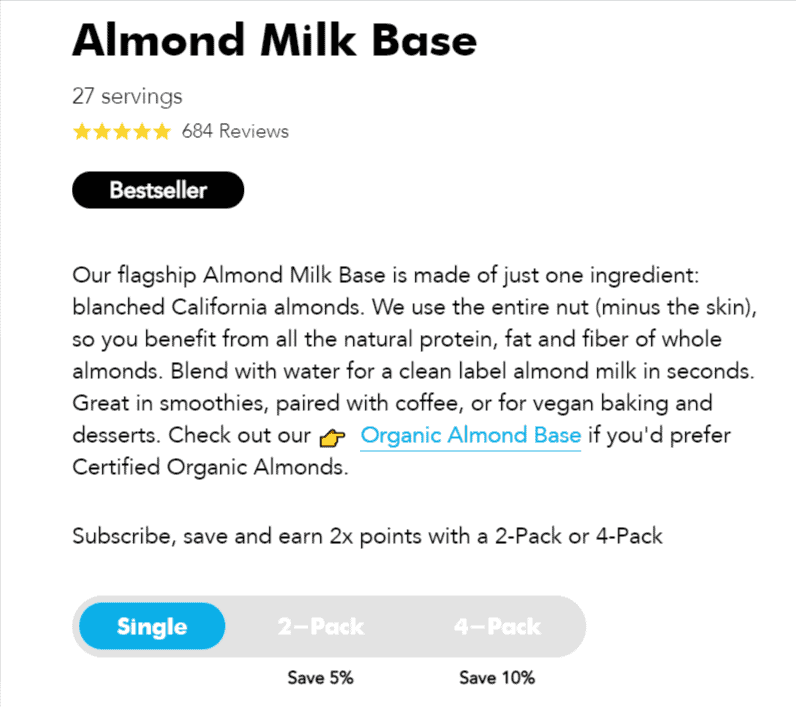
What makes this copy great is how it addresses plenty of common objections right from the first sentence while showing how it works (just blend on water).
Many shoppers in the health space worry if a product is really natural and safe to use, so almond milk that’s only made with almonds is the correct statement to start with.
It also gives use case examples such as smoothies, coffee, or ice cream—validating that this product does work for said purposes.
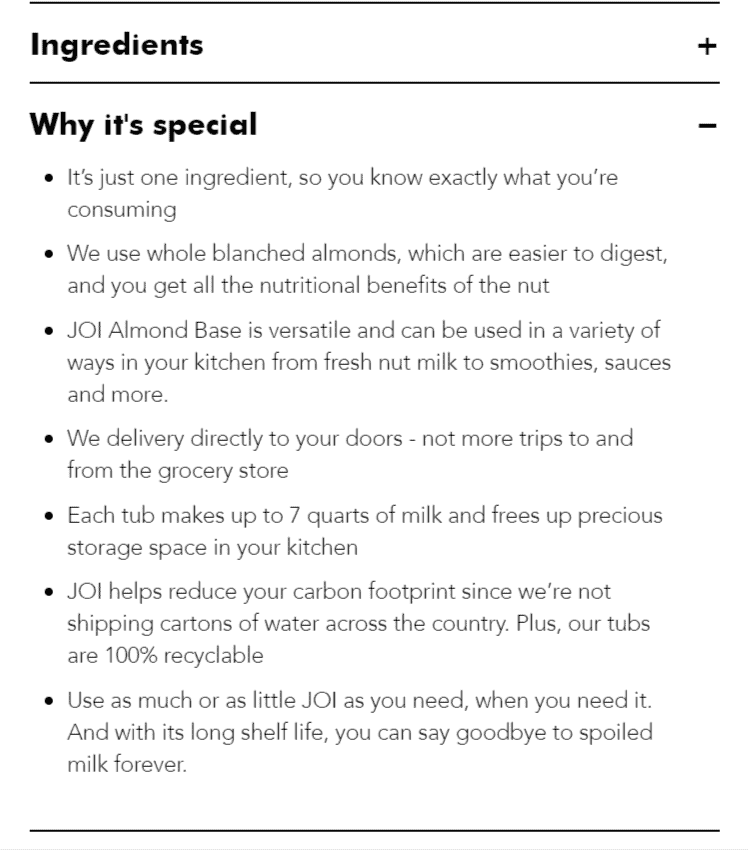
Further than that, after scrolling a little bit, you’ll find a section on why the product is special, going through all the aspects that makes the product unique—which can make the difference between buying and bouncing back.
Example #2. Kroma’s Latte

One of the first things you read on this product page is that this latte is:
- Paleo Friendly
- Preservative-Free
- Soy-Free
- Dairy-Free
- GMO-Free
- Gluten-Free
- Vegan
It removes all the common objections from their target audience at first sight. Plus, the description starts comparing itself with the kama sutra, which will definitely spark intrigue in the right people.
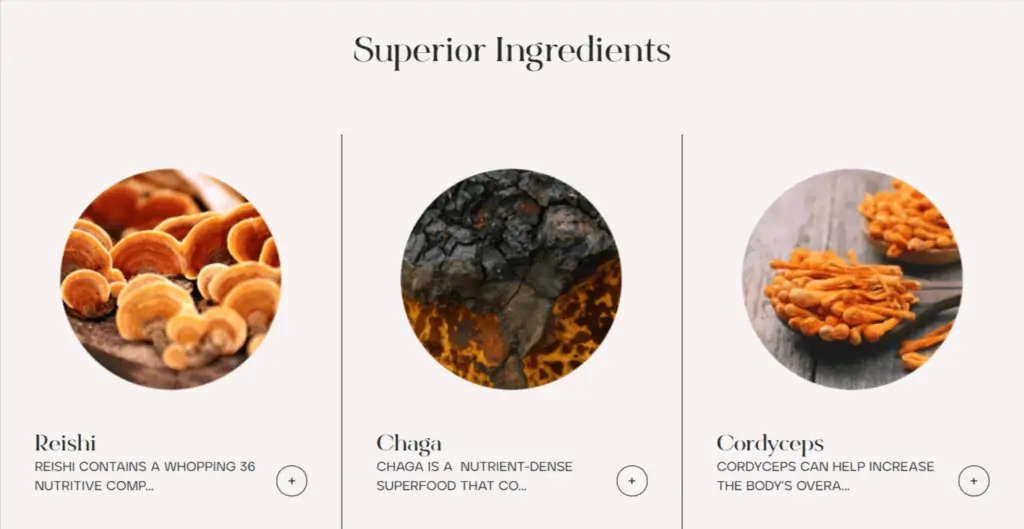
What’s also great about the copy is how it breaks down the ingredients, explaining the benefits that each component contributes to the product. This way, prospects can have a better understanding of the product and be more excited about it.
Example #3. Rawrycat’s Cabin
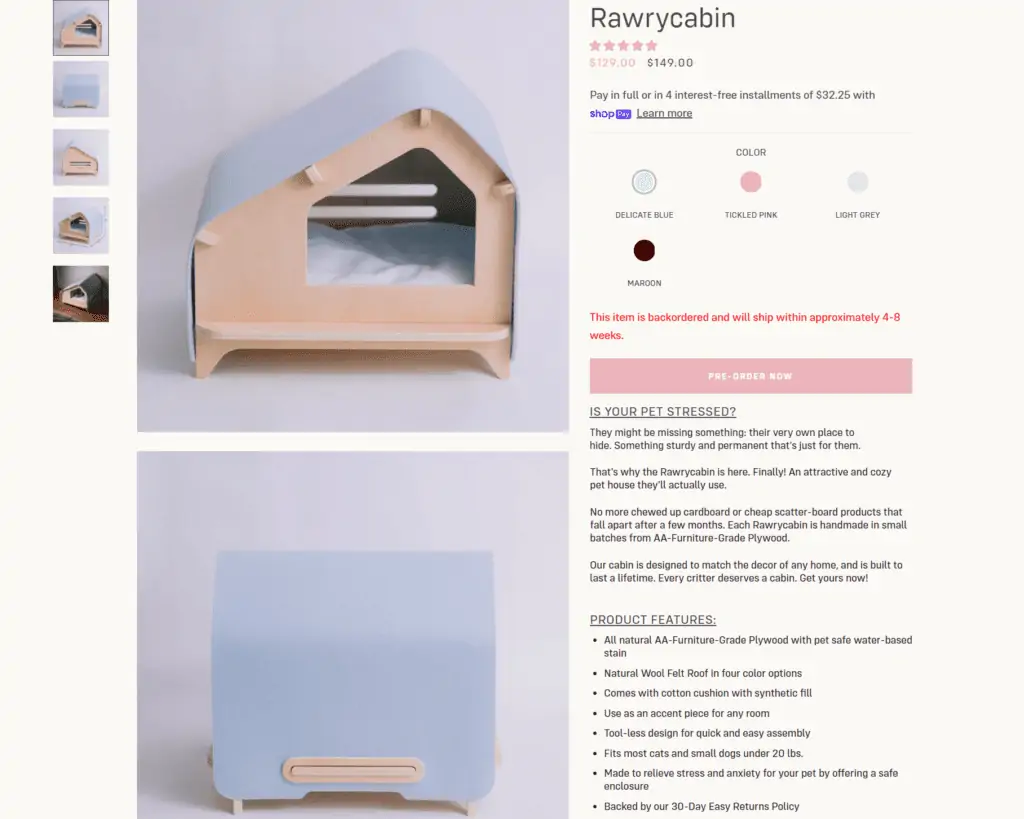
The only text you can read after loading the page is “is your pet stressed?”
It isn’t just a common concern among pet owners. It also generates enough intrigue in the prospects in them to scroll down and read more.
Once you scroll, you notice that the product description isn’t a block of text. The copy is structured with simple language and broken down into short paragraphs. While also showcasing the product’s features in bullet points instead of compiling them in one sentence.
What’s better, it also includes an FAQ that answers most people’s objections when buying online, including a 30-day moneyback guarantee with no questions asked. FAQs are great for helping the most doubtful prospects.
Example #4. The Healthy Place’s Fish Oil Supplement

Even though you need to scroll down a little bit to find the description, the structure of this copy is what checks all boxes.
- It addresses a common pain point.
- It explains why the product is unique and how it’s made.
- Adds all the benefits in bullet points.
- Addresses a common objection with fish-based products (fishy taste).
- Finishes the copy with a call-to-action.
Besides, the page’s format makes it more pleasant to navigate and read the copy instead of compacting it on the right side of the page. You can go through many tabs to learn how to use the product, its details, and reviews.
Example #5. One Ocean Beauty’s Moisturizer
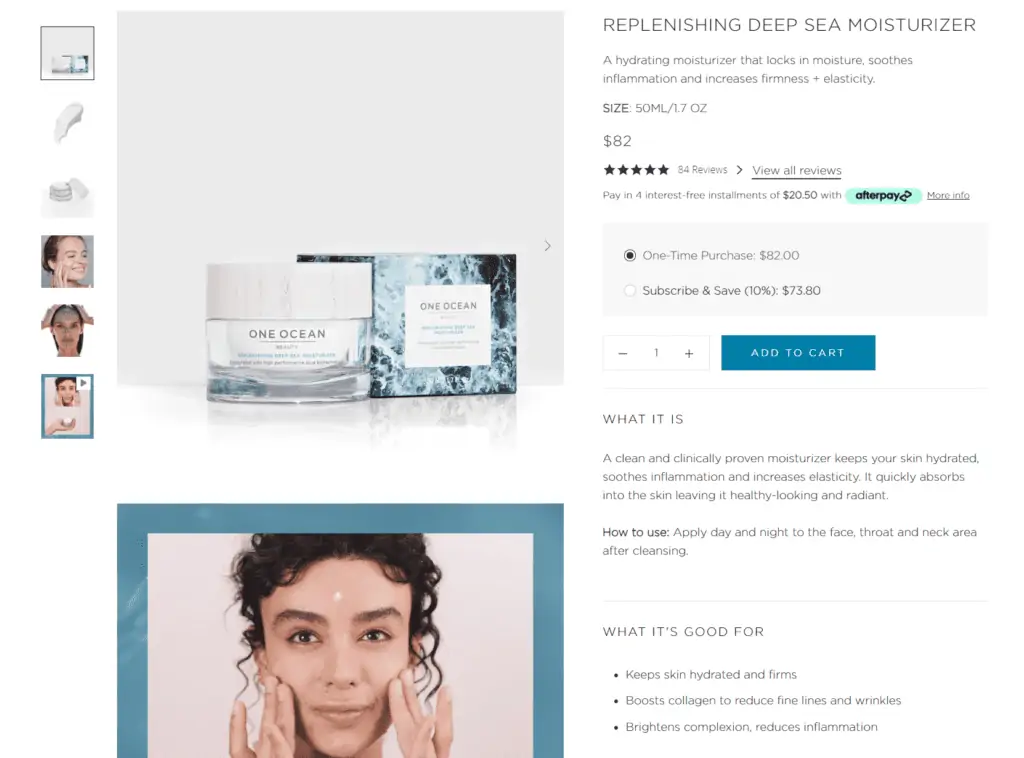
One Ocean Beauty is a perfect example of how to break down a product description. It clearly defines what the product is, what it’s good for, and how to use it. While labeling the product as:
- Natural
- Sustainable
- Age-defying
- Cruelty-free
The copy also features the product’s key ingredients and explains the role each plays in the moisturizer. Making you understand why the product does what it says it does.
And to finish off, it adds the ultimate proof prospects need to trust the brand—showing all the clinically proven results the product had on hydration, collagen levels, and elasticity.
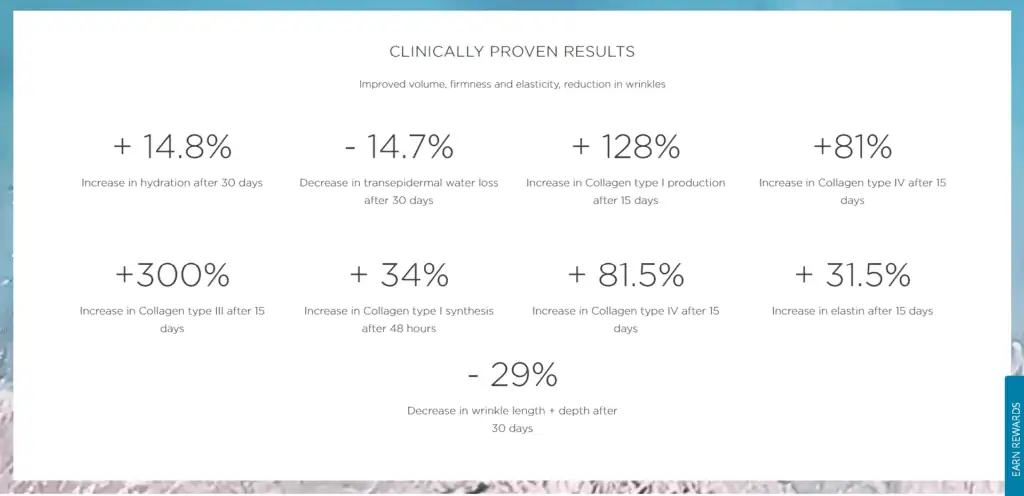
This brand clearly demonstrates how you should tackle customers’ objections.
Go the Extra-Mile with Your Product Descriptions
Product descriptions are one of those things that are so standardized that people assume they know how to write one.
In reality, the best copy comes from brands that decided to invest more thought into it—ensuring that it truly catches customers’ attention and influences their buying decision.
This guide covered the most fundamental elements of a product copy that stands out and makes sales, including:
- Pain points.
- Anti-objections.
- Stories.
- A clean and easy-to-read format.
- Social proof
- Call-to-actions
What’s better, you can start following this guide right now before experimenting with more complex strategies—making your life a bit easier.
Remember, product descriptions are all about covering objections until the prospect has no reason not to buy.
